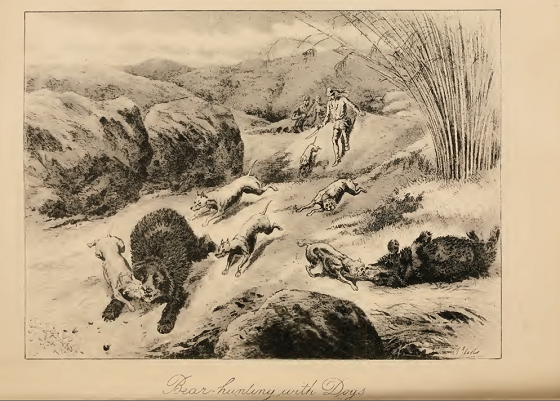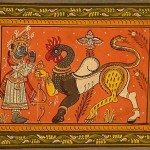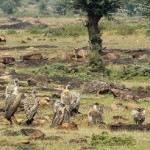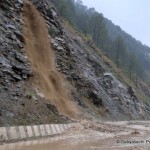THIRTEEN YEARS AMONG THE WILD BEASTS OF INDIA: By George P. Sanderson
THEIR HAUNTS AND HABITS FROM PERSONAL OBSERVATION; WITH ANACCOUNT OF THE MODES OF CAPTURING AND TAMING ELEPHANTS
In our effort to bring to light books on natural history to the new generation ofreaders, I have gone back in time by more than a hundred years to the late 1800swhen George P. Sanderson had written the Thirteen Years Among the Wild Beast ofIndia.

THIRTEEN YEARS AMONG THE WILD BEASTS OF INDIA: By George P. Sanderson
It was the original idea of Sanderson to try and capture a herd of elephants and hewas granted permission after 8 months. Before this attempt, Hyder Ali had made afailed attempt at catching a herd of elephants and had even given a curse thatanyone attempting such a misadventure is bound to fail. At that time no one hadbelieved that one could capture a herd of elephants. He details his approach, his firstfailure and the amount of planning and drills that he had done with his men for thesecond attempt which became a success. Sanderson later oversaw the kheddahoperations in Bengal in the Chittagong district.
Sandersons book Thirteen Years Among the Wild Beasts of India is an interestingread not only to learn about the elephant catching operations that he undertook, butalso because it gives us a third party view of the country, the prevalent society,social mores, religion, apart from the state of wilderness and wildlife a hundred andthirty five years ago.
Society:
Sandersons observations about the various social strata is keen and some of whichis even relevant today. Sanderson writesThe Hindoo people of Mysore are peaceful, orderly, and good-natured, but lacking inenterprise. The Brahmins are intelligent and ambitious ; they have always filled mostof the posts in Government offices. The Mussulmans have sunk into deep poverty,chiefly through their own laziness, since the overthrow of the Mussulman power in1799. A few engage in mercantile and agricultural pursuits ; many are enlisted in theMysore Horse and the Sepoy corps ; they also find employment as elephant and camelattendants, and horse-keepers. The domestic servants of Europeans in Mysore are allMadrassees, as the Canarese people have never taken to indoor service.
Irrigation System:
In India today, when major parts of the country is facing drought and the so calledexperts are giving grandiose suggestions of constructing mega dams and riverlinking, Sanderson is also all praise for the irrigation system.
The country is well cultivated in many parts, the wisdom of former rulers havingprovided it with irrigation, both by channels drawn from the rivers passing through it,and from tanks or lakes formed by embankments thrown across the valleys. Theseancient works are constructed upon such scientific principles that little can bedone by European engineers to improve them. The lakes store the surplus rain-water for the use of the land further down the valley, and the cultivation thusartificially watered is called “wet” in India, in contradistinction to “dry,” or thatdependent on rainfall alone. Wish we could revive our long-lost traditional waterharvesting and management systems.
Wilderness:
His writings gives us a sneak peak of the wilderness. While describing jungle fires,he writes that there have been trees so enormous that the fire was smouldering inthe tree for a long time. Long after the main conflagration has passed, isolatedbamboo-clumps and dried trees are seen burning fiercely like pillars of flame, till theyfall over with a sullen crash, and are quenched. Many trees smoulder for months. Iknew one of enormous size, the roots of which, some of the girth of a bullock, orgreater, burnt for three and a half years, the fire smouldering slowly underground inthe roots long after the parent stem had fallen.
After the introduction of wood-cutting as a major revenue of the forest department,some of the pristine forests had been felled. With the demand of wood soaring updue to increased demands from railways and other enterprises as well as fromindividuals, our forests are no longer the same. So his observation of trees withmassive roots may appear as gran-mas tales to some people.
On Cruelty:
Like many of the British in India in those days, Sanderson had participated in cruelbloodthirsty pursuits of hunting wild animals with dogs. In the chapter Bear Hunt,he has written about unleashing a pack of dogs on sloth bears and proudly mentionsthat he had only to use a knife to put an end to the bear. He also mentions releasinga panther from cage and unleashing the blood hounds to restrain and kill it. Callingit a sport, he has given detailed descriptions of the dogs and his methods.

Bear hunting with Dogs
His take on cruelty of Indians in his era:
Natives’ ideas of cruelty are peculiar. They differ widely from ours. They think nothingof letting a domestic animal, with broken limbs or sores swarming with maggots,linger to death rather than raise a finger to put it out of its misery. They wouldconsider taking its life under any circumstances cruel. Humanity as understood by us isa feeling of which they have no conception. When orders are issued at certain seasonsby Government for the destruction of starving and half-rabid pariah dogs, by whichIndian towns are infesteda merciful course to the animals themselves, and onenecessary for the protection of the publiceven educated Hindoos are seldom wantingto raise an outcry against the step. The same men would pass, without notice or pity, adonkey or cow by the roadside suffering from raw wounds at which crows werepecking (no uncommon sight in India), whilst the maddened animal made vainattempts to defend itself. I have never heard any native when with me shooting suggestsuch a thing as putting a wounded animal out of its pain. They have frequently said, “Why waste another bullet on it ? it will die.” A Sholaga (hill-man) in my employrecently found a bison in an elephant pitfall; he had a gun, but rather than expend ashot on an animal that was useless to him, he left it there to starve to death : it did notdie till the thirteenth day. When my men caught pea-fowl in snares they would put outa feather, poke the stem through both eyelids, and fasten up the birds’ eyes, to preventthem fluttering and spoiling their plumage, which ” master would want.” None of mymen ever thought of sparing the youngest animal we might find in the jungle. Ifpermitted to do so, they would consign fawn or leveret, whose helplessness might havebeen expected to excite even their compassion, to the game-bag without a regret,except at its size. (page 24)
On Religion:
While talking about religion Sanderson writes Personally I have learned to respectthe feelings and earnestness of the simple village communities around me. I can saythat there is not a hypocrite in the country-side, nor one who decries the religion of hisneighbourrather a contrast in the latter respect to the jealous wranglers of variousdenominations who do their own causes injury by their intolerance of each other in thesame mission-field.
Great swimmers:
He writes about the remarkable ability of elephants to swim long hours A batch ofseventy-nine that I despatched from Dacca to Barrackpur, near Calcutta, inNovember 1875, had the Ganges and several of its large tidal branches to cross. Inthe longest swim they were six hours without touching the bottom; after a rest on asand-bank, they completed the swim in three more ; not one was lost. I have heardof more remarkable swims than this.
Gentleness of Elephants:
Sanderson who caught many elephants writes about their gentleness:
It is exceedingly entertaining to note the gravity of young calves, and the way inwhich they keep close to their bulky mothers. The extreme gentleness of elephants, thecare they take never to push against, or step upon, their attendants, doubtless arisesfrom an instinctive feeling designed for the protection of their young, which a rough,though unintentional, push or blow with the legs of such huge animals would at oncekill. Amongst all created creatures the elephant stands unrivalled in gentleness. Themost intelligent horse cannot be depended upon not to tread on his master’s toes, andif terrified makes no hesitation in dashing away, even should he upset any one in sodoing. But elephants, even huge tuskers whose heads are high in the air, and whosekeepers are mere pigmies beside them, are so cautious that accidents very seldomoccur through carelessness on their part. In the kheddahs, though elephants areexcited by struggling, they never overlook the men on foot engaged in securing thecaptives ; and though there would seem to be great danger in being amidst the forestof huge legs and bulky bodies of the tame elephants, they evince such wonderfulinstinct in avoiding injuring the men that I have never seen an accident occur throughthem.
Under-fed elephants:
Sandersons observations about under-fed elephants suffering is still valid today asmany elephants in temples and in other private custody immensely suffer due tostarvation.There is, perhaps, no animal less liable to sickness than the elephant if well fed. Thispoint is of paramount importance, and without it good management in other mattersis of no avail. It is common enough to see elephants in poor condition, suffering fromnothing but partial starvation, being treated with medicines and nostrums for debility,whilst their appetites are good, and they only require a sufficiency of fodder to effect acure. It may truly be said that all ailments to which elephants are subject are directlyor indirectly caused by insufficient feeding. Under-fed elephants become weak andunable to stand exposure ; they cannot perform their work, and are laid open to attackby even such remote maladies as sunstroke and sore back through poor condition.(page 98)
Apart from that there are many other interesting points in the book.This book is rare to find, however it has been digitised and available for noncommercial use. It can be downloaded from this link:
https://ia600409.us.archive.org/28/items/thirteenyearsamo00sandrich/thirteenyearsamo00sandrich.pdf
It is also available in Amazon in Kindle for reading with a Kindle reader ordownloading it to your computer by using the Amazon Kindle software. This is thedigital copy of the second edition published in 1897 and it costs about 493 rupees($7.59 usd).
- Canon Launches Cine Servo 11-55 mm T2.95-3.95 lens - 10 September,2025
- Water Monitor Lizard in Sundarbans - 14 May,2025
- Radio collared Tigress - 30 January,2025











It’s a nice, elaborate review. We need to know about more such books. Thanks for the download link… :-)a href=”” title=”” rel=””>
Thanks Maniparna,
I am happy that you liked it.
Cheers,
Sabyasachi
I happen to own a copy of ‘Thirteen Years Among the Wild Beasts of India’ passed on to me by my grandfather and father. It is a copy printed in the late 1800’s. It’s a real treasure to read.–Najmi Salim
Dear Najmi,
Wow! Great to know that you have a printed copy of “THIRTEEN YEARS AMONG THE WILD BEASTS OF INDIA: By George P. Sanderson”. And it is nice to know that this book has been in your family from your grandfathers time. It is a book to be treasured and the one doesn’t get it in the market readily. Once I missed a chance to get a copy of the first edition and have been looking since.
It is not an easy task to preserve such old books. However they outlive us and continue to inspire generations.
Cheers,
Sabyasachi